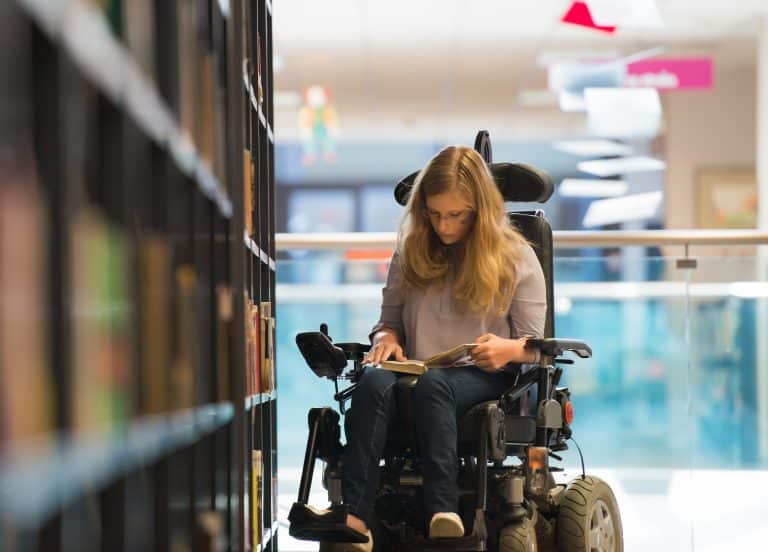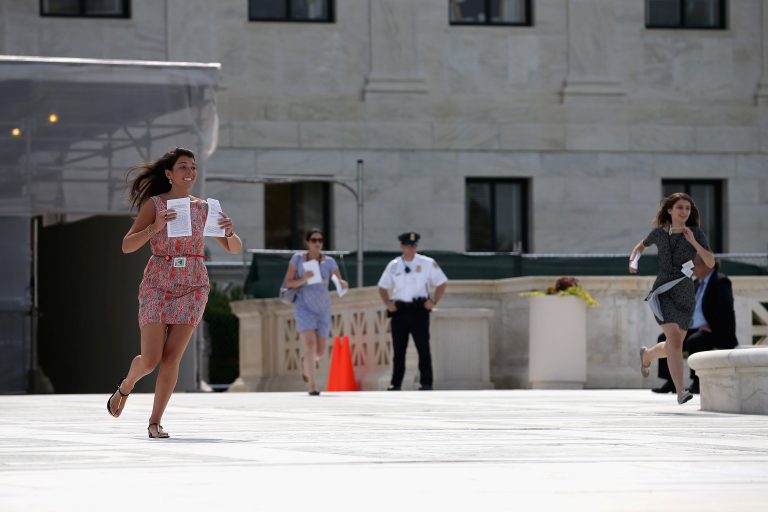
Image by Tashi-Delek/Getty Images, © All Rights Reserved.
I’m a Disabled Woman Who Wants to See More Literary Characters Like Me
The first time I saw my Berlin physiotherapist, she lent me a cane. She held it up before me like a stern parent wagging a finger. Besides stretching our contracting joints and massaging our stressed, shrinking muscles, it’s her job to advise people with muscle disease about mobility and everyday functioning. Every few weeks, she’ll ask me, “Is everything okay?”
I always say yes, or I say I’m tired, just tired. My physiotherapist can foresee my body’s problems of the future, an oracular gift I often don’t appreciate, and also says I have to learn to tell strangers how they can help me. My psychiatrist says I have to focus on the things I can do, not the things I no longer can. I don’t disagree with either of them, but I can’t help but recoil when people who haven’t been in my place glibly offer counsel on what my body can do.
Oftentimes, the assumptions and summary judgments of others challenge my basic competence and agency as an individual. Some would say it’s my task to educate them; to help people recognize this evolving version of me as different, not diminished. But I struggle to teach them. I am a product of the same ableist society, after all, and I too have much internalized ableism to unlearn. On my worst days, I struggle not to see myself as a vessel for pity or contempt.
I’m connected online with others facing similar challenges, and I’m grateful for that. But I don’t see a lot of women like me out in the world — usually because of lack of accessibility — and I don’t see them in pop culture either: not in TV shows, not on film, not in fiction. For me, becoming disabled in middle age feels not unlike a second coming-of-age, complete with a newly confounding body. Just as I did in adolescence, I’m looking for examples of strong, determined people who live lives like mine and do the things I want to do. I’m searching the cultural landscape for references, role models, and it’s not easy to find them. I don’t see or read about many women simply living their lives while disabled.
*
According to the 2010 Census, 19 percent of people, or 56.7 million people in the U.S., are disabled. Like me, about 31 million people have mobility issues, and 20 million experience difficulty with upper body functioning. Yet people with physical disabilities are not people I see in literature, where the default body is omnicompetent, unremarkable in its capacity for untroubled function. When characters with disabled bodies do turn up in books, I hope for the best but prepare for the worst. Harmful tropes about disability and disabled characters are much more common than any kind of nuanced, realistic view — any semblance of norming disabled people, or even just respecting them.
Consider two recent best-selling, critically praised books, Me Before You by Jojo Moyes (also a 2016 film) and A Little Life by Hanya Yanagihara. Moyes’ novel tells the story of a man named Will Traynor who sustains a spinal cord injury in his thirties; as a result, he has quadriplegia, uses a wheelchair, and requires daily care assistants. Will finds it enormously difficult to adjust to these radical changes to his body and mobility; what is out of the ordinary is his unwavering determination to end his life. It is neither realistic nor empathic to portray life with a physical disability as so horrendous that a person may well be better off dead. Similarly, Jude Francis, the central character of A Little Life, lives with disability — a combination of mental illness (including PTSD) and mobility restrictions caused by physical abuse, disease, and amputation. Racked with self-loathing and internalized ableism, Jude deplores above all “being a burden,” and attempts suicide more than once; after the crushing loss of his partner, he grows ever more determined to succeed.
The characters of Will and Jude are used instrumentally, in both these novels, as “narrative prostheses.” A narrative prosthesis is a tool for solving certain challenges of writing fiction — developing character, plot, and theme — by turning the disabled character into a stereotype, a device, or a metaphor. Worst is when a disabled character functions primarily as breathing metaphor for psychic, spiritual, or social ills: An aberrant body is coupled with a broken or aberrant soul, the physical “damage” the external face of the darkness within. Often they serve as merely the means to an end, a perpetuation of ableist thinking that construes and objectifies people with deformity or disability as inherently pitiable, powerless, defeated.
As a woman with progressive degenerative muscle disease struggling to break free of these ideas, it chills to find them fervently presented as wisdom — even examples of empathy! — in popular novels, instead of as the misrepresentations and aggressions they are. We need prominent disabled characters created by disabled writers to erode the damage done by a long procession of invisibility and harmful portrayals that stoke antipathy.
*
Not long ago, I read a post on novelist Nicola Griffith’s blog titled “Coming Out as a Cripple.” In 1993, in the same month her first novel was published, she learned she had multiple sclerosis. Her disease progressed slowly, and she tried to push it as far out of her mind as she could. She subscribed to what she called the “Small Dog Theory” of illness: “Keep the irritating, yappy little hairball fed and watered and it won’t annoy you as much.” I know that strategy, I thought.
But Griffith eventually concluded that the Small Dog Theory is bullshit. Being disabled can’t be separated from life, daily experience, or our identities, which are in no small part forged through our continual struggle for recognition — the soul-crushing clash with cultural attitudes and built environments that dismiss and exclude us. I’ve tossed out my own version of the Small Dog Theory, whereby I spent years denying that living with progressive muscle disease would have no bearing on who I am — I have integrated my disability as something that is part of me, rather than conceiving of it as a foe with whom, when forced, I skirmish — but I still have to work, at times quite hard, at rejecting ableist images of myself.
We don’t usually think of people in middle age as needing role models, but maybe we should. “The process of inventing your life seems to go on all your life,” fifty-eight-year-old Molly Peacock wrote in her essay “Passion Flowers in Winter” (included in the Best American Essays 2007 anthology). “Where are the readily apparent models for all of us who still consider that we are inventing a life?”
Peacock had also searched for role models “through the forests of characters’ lives in stories and novels.” As part of the blithe caste of middle-class, able-bodied, straight white cis-women, it was once simple for me to find strong models in those same forests. I could afford to shirk questions of representation or its absence as long as I could essentially “pass” — as long as my disability was more or less invisible; as long as I didn’t have to ask flight attendants to haul me up from an airplane seat; as long as I could do things like wash my clothes without courting exhaustion.
I was excited to talk about this with Nicola Griffith, as someone who’s also transitioned to a disabled identity in midlife and besides creates fictional characters for a living — with her new novel, So Lucky, which both is and isn’t about living as disabled, she’s one of the writers who are actively creating disability culture. We chatted over Skype, Berlin to Seattle, about why we look for disabled characters in the books we read and why good representations would make a difference. “It helps to see someone else coping,” she told me. “We all borrow from fictional characters. But there aren’t enough good crip characters to borrow from, so we’re all learning on our own. It shouldn’t be that hard.”
Women with disabilities barely seem to exist in fiction, let alone queer women with disabilities or women of color with disabilities or queer, non-binary or trans women of color with disabilities. “You only seem to be allowed one degree from the norm,” Griffith said. “If the norm is straight white rich boys, then you can be a woman, you can be queer, you can be crippled, but you can’t be all those things.” In other words: You have to fight to be seen as a normal person living a normal life.
Other disabled writers and artists are working to create and encourage the representation we need and deserve. Last year, Griffith connected online with Alice Wong, an activist who runs the Disability Visibility Project with the goal of sharing and boosting disability stories and culture. Together, Wong and Griffith launched a series of #CripLit Twitter chats.
“We wanted to create and offer another space about writing, representation, and of course disability diversity in literature,” Wong explained in an email. “It’s a great way for writers, editors, and publishers to find one another and to learn from d/Deaf and disabled writers.”
Wong had been thinking about these issues a long time. “I never saw myself represented in fiction when growing up disabled and Asian American,” Wong said. “This absolutely had an impact on the way I viewed the world and how society views people like me. Most non-disabled people don’t realize how the world is centered on able-bodiedness, with disabled people on the periphery.”
Another vital project (now on hiatus) is Disability in KidLit, an online resource established by disabled authors and editors to help readers find and recognize good portrayals in middle-grade and YA fiction. We Need Diverse Books has been a fierce advocate of diversity in children’s literature since 2014. In 2016, the co-founder of Disability in KidLit, YA novelist Corinne Duyvis, created the hashtag #OwnVoices to boost books featuring characters from a marginalized group by writers from the same group. Kids’ lit is out in front in offering strong portrayals of disabled characters, with authors like Duyvis, Tess Sharpe, Leigh Bardugo, and John Green norming disability by creating nuanced disabled characters. If I were an adolescent today, I’d be able to recognize my disabled self in their work as I once recognized my changing self in Judy Blume’s novels. As a middle-aged, disabled woman looking for characters in adult literature whose lives resemble mine, though, I’m coming up short.
I can find some writers telling their disability stories in a cluster of lit journals, like D/deaf Poets Society and the Tiny Tim Literary Review. They’re doing great work, but it’s important that abled people are exposed to our stories, too. In traditional publishing, the bigger houses have shown little interest in some memoirs of chronic illness and disability; even less so in novels or story collections centering disabled characters.
Smaller presses tend to have a stronger interest in marginalized writers, but it’s still hard to find many indies making a concerted effort to publish disabled writers. One glowing exception is Handtype Press and its newer imprint, Squares & Rebels. Handtype publishes the work of Deaf authors and signers, exploring and celebrating the Deaf signing community in poetry, fiction, essay collections, and memoirs. Squares & Rebels focuses on queer disability narratives; It’s Just Nerves is a recent standout, a bracing essay collection from poet Kelly Davio that fuses cultural criticism with a fierce vision of living well with disability. But for all the small gains we’ve made, it will be difficult to find the stories we need if publishers fail to seek them out and think critically about the disability portrayals that do exist.
*
The circuit of non- or poor representation is a feedback loop, affecting how abled people think of disabled people and how we, in turn, see ourselves. Sometimes a wave of self-contempt still ripples through me when my arms are not strong enough to fasten a tight pair of jeans, or when I have to ask a stranger in a Manhattan bar to help me with my jacket. As I consider anew questions of identity, I’m viewing myself from still-alien angles. And as my disease progresses, I don’t know what my body will be able to do next month, or even tomorrow. I can say that everything is fine, fine, fine — until suddenly my adjustments don’t work anymore, and then I sometimes slide into panic. Can I be a tough, independent woman if I can’t wash my own hair? But who says I can’t?
In my own life, I’d love to be able to borrow from a deep well of disabled literary characters; to find in them role models, mentors of a kind. Instead, people like me looking for these portrayals in literature are mostly learning on our own — and we’re expected to educate the non-disabled world while we’re at it. In the “story forests” of novels and short stories, I want to come across more characters — or even just one — who is like me: a disabled adult woman living with purpose, inventing a life.
This essay was originally published on Catapult. It is reprinted here with permission.

